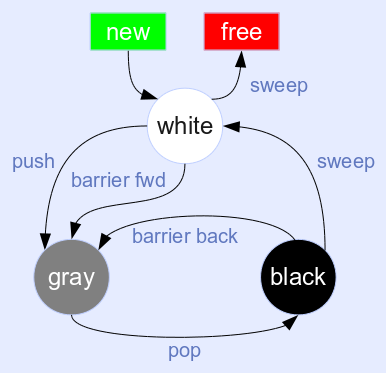
New Garbage Collector http://wiki.luajit.org/New-Garbage-Collector
GC Algorithms
This is a short overview of the different GC algorithms used in Lua 5.x and LuaJIT 1.x/2.0 as well as the proposed new GC in LuaJIT 3.0.
All of these implementations use a tracing garbage collector (#) with two basic phases:
- The mark phase starts at the GC roots (e.g. the main thread) and iteratively marks all reachable (live) objects. Any objects that remain are considered unreachable, i.e. dead.
- The sweep phase frees all unreachable (dead) objects.
Any practical GC implementation has a couple more phases (e.g. an atomic phase), but this is not relevant to the following discussion. To avoid a recursive algorithm, a mark stack or mark list can be used to keep track of objects that need to be traversed.
Note that most of the following is just describing well-established techniques. Please refer to the literature on garbage collection for details.
(#) 'Tracing' in this context means it's tracing through the live object graph, as opposed to a reference counting garbage collector, which manages reference counts for each object. The terminology is not related to the concept of a trace compiler.